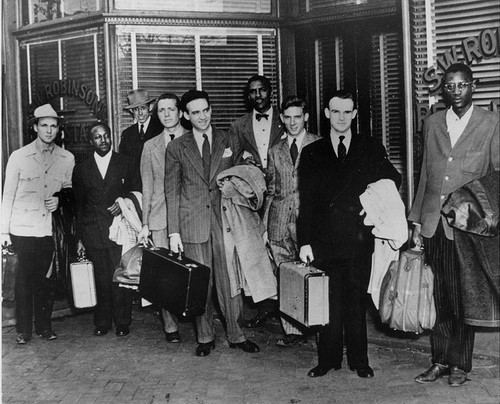Date April 9–23, 1947 DeathsInjuriesArrests 16 DeathsInjuries | Result Inconclusive | |
 | ||
Location | ||
Journey of Reconciliation was a form of nonviolent direct action to challenge segregation laws on interstate buses in the Southern United States. The two-week journey by 16 men began on 9 April 1947. It was seen as inspiring the later Freedom Rides of the Civil Rights Movement. James Peck, one of the white participants, also took part in the Freedom Ride of May 1961.
Contents
Bayard rustin journey of reconciliation
History
Sixteen men from the Congress of Racial Equality (CORE) took part, eight white and eight black, including the organizers, white Methodist minister George Houser of the Fellowship of Reconciliation (FOR) and CORE and black Quaker Bayard Rustin of FOR and the American Friends Service Committee. The other black participants were Chicago musician Dennis Banks; Andrew Johnson, a student from Cincinnati; New York attorney Conrad Lynn; Wallace Nelson, a freelance lecturer; Eugene Stanley of North Carolina A&T College; William Worthy of the New York Council for a Permanent FEPC; and Nathan Wright, a church social worker from Cincinnati. The other white participants were North Carolina ministers Louis Adams and Ernest Bromley; Joseph Felmet of the Southern Workers Defense League; Homer Jack, executive secretary of the Chicago Council Against Racial and Religious Discrimination; James Peck, editor of the Workers Defense League News Bulletin; Worth Randle, a Cincinnati biologist; and radical pacifist Igal Roodenko.
The participants planned to ride public transportation in Virginia, North Carolina, Tennessee, and Kentucky, all with segregated systems. During the two-week trip, blacks sat in front, whites in back, or sometimes side-by-side, all in violation of current state laws which required passengers to practice segregated seating in buses.
They were supported by the recent 1946 U.S. Supreme Court ruling in Irene Morgan v. Commonwealth of Virginia, 328 U.S. 373 (1946), which prohibited segregation in interstate travel as unconstitutional, by putting "an undue burden on commerce." The Southern states were refusing to enforce the Court's decision. Based on consultation, the protesters limited their direct action to the Upper South, where the risk of violence was not as high as in the Deep South.
The riders suffered several arrests, notably in North Carolina. Judge Henry Whitfield expressed his distaste for the white men involved:
"It's about time you Jews from New York learned that you can't come down here bringing your niggers with you to upset the customs of the South. Just to teach you a lesson, I gave your black boys thirty days [on a chain gang], and I give you ninety."
The NAACP and Thurgood Marshall had reservations about the use of direct action, expecting to provoke much violence with little progress toward civil rights. The NAACP did offer a limited amount of legal help for those arrested. Bayard Rustin believed that the Journey of Reconciliation, as well as other actions challenging segregation in these years, contributed to the eventual ruling of the US Supreme Court in 1954 in Brown v. Board of Education. It ruled that segregated schools were unconstitutional and ordered them ended.
